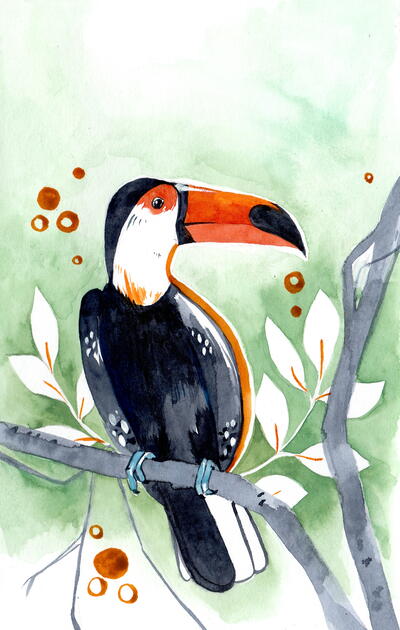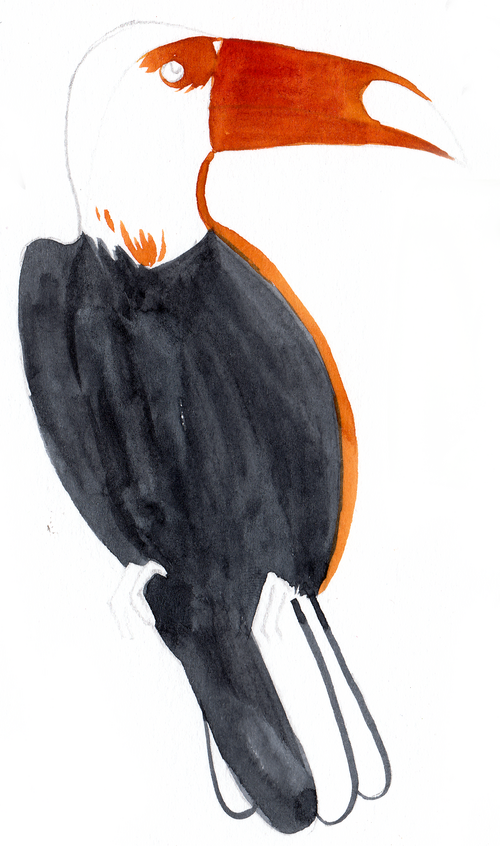Toco Toucan

These lovely ivory black birds with their bright orange beaks can be easily spotted anywhere in rainforests. Toco toucans are the largest and most well-known toucan species. In terms of painting, toucans can be slightly more difficult to paint because they are black. Another aspect is to ensure that the background doesn’t overpower the painting. If we choose the wrong color, it could make the painting dull. Hence, we need to plan the color scheme carefully.
Materials List
- Watercolor cold press paper, 200gsm (95lb)
- Pencil
- Kneadable eraser
- Palette
- Glass cup
- Watercolor mop brush, size 000
- Round brush, size 4
- Script liner brush, size 0
- Tissue paper
COLOR SCHEME:
Ivory Black
Bright Orange
Chrome Yellow
White acrylic paint
Sea Foam Green (can be made by adding a dash of White watercolor paint to Hunter’s Green)
DIRECTIONS
-
Drawing toucans is fairly simple. With a pencil, start with an oval for the face of the bird and a larger oval shape for the body of the bird. Next, add a big, elongated beak. Add the eye and a line across the face for the top part of the head. Now for the bottom part of the body—draw in the feet details as shown in the highlight image. Then, complete the tail of the bird with long U-shapes. Erase any darker lines with a kneadable eraser so that it doesn’t affect the final painting as we move on to painting our first layer.
-
Let’s start painting our first layer of the bird by using a round brush. This is a very easy step. Simply paint a translucent layer of black for the body of the bird. This light wash can be created by mixing more water into the paint. With the same brush, outline the bird’s tail feathers.
Allow the layer to dry before moving on to the next step. -
In this step, let’s add orange and yellow details for the bird using a script liner brush for better control. Start with loading your clean brush with bright orange and paint the beak and the eye. For the beak, I like to use a dual-color gradient of bright orange to chrome yellow. Make sure to wash your brush completely before loading it with a new color. That way, the colors remain vibrant and not mucky. Next, paint some simple jagged lines along the neckline. Finally, paint the outline of the bird along one side. This outline creates the effect of shadow and depth. Allow the layer to dry before moving on.
-
In this step, we are going to add more depth to the black part of the bird using your script liner brush. We will be using a saturated layer of ivory black. Before loading the brush, make sure to wash it of any previously used colors. Now, for the second layer of ivory black, use jagged lines along the left shoulder, the body and the tail feathers. I also like to add some spot textures for wing feathers.
Next, we can paint the eye, top of the head and small parallel lines around the face. Complete the beak shape by filling in the remaining areas and the middle line. You can paint the bird’s feet whatever color you’d like (I chose a bright blue). Allow the layer to dry before moving on to the next step. -
Let’s complete the painting by adding the background. Before that, it is important to add white acrylic details for the bird by using the script liner brush. Make sure to wash it before dabbing it in white acrylic paint. Now, add dots for the eye and a cluster of spots for the wings of the bird.
For the background, let’s try a different technique. Instead of painting inside the leaf, let’s paint around it. This is also known as the negative painting technique. To start, draw the branch and the leaves around the bird lightly, using a pencil. I like to draw large leaves to balance out the thin branch. Next, use the mop brush loaded with seafoam green to paint around the leaves and the branch to create the effect. So that we aren’t left with a flat sea-foam green wash, clean your brush and glide it along the edge of the sea foam line. This will create a single gradient effect.
Allow this effect to completely dry before loading your round brush with some ivory black to paint the branches. Finally, switch the color in the brush by cleaning out the black paint and loading it with bright orange. Use bright orange to add circles around the bird and to add thin stems to the inner leaves.
Read NextSilly Christmas Painted Rocks


























